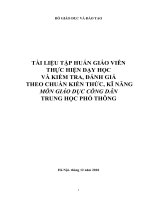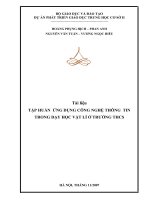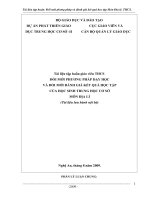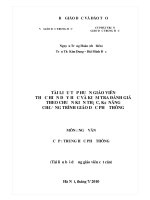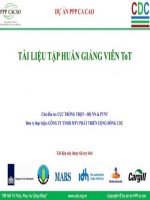TÀI LIỆU tập HUẤN GIẢNG VIÊN dạy CHUYÊN NGÀNH BẰNG TIẾNG ANH
Bạn đang xem bản rút gọn của tài liệu. Xem và tải ngay bản đầy đủ của tài liệu tại đây (1.25 MB, 53 trang )
TÀI LIỆU TẬP HUẤN GIẢNG VIÊN DẠY
CHUYÊN NGÀNH BẰNG TIẾNG ANH
KHOA: CÔNG NGHỆ THÔNG TIN
MỤC LỤC
BÀI 1: KINH NGHIỆM XÂY DỰNG CHƯƠNG TRÌNH MÔN TIẾNG ANH
CHUYÊN NGÀNH 1 VÀ 2 ............................................................................................. 2
BÀI 2: KINH NGHIỆM XÂY DỰNG CHƯƠNG TRÌNH VÀ BÀI GIẢNG
MÔN “LẬP TRÌNH HƯỚNG ĐỐI TƯỢNG VỚI C++” ...................................... 14
BÀI 3: KINH NGHIỆM XÂY DỰNG CHƯƠNG TRÌNH MÔN CẤU TRÚC
DỮ LIỆU VÀ GIẢI THUẬT ........................................................................................ 25
BÀI 4: KINH NGHIỆM XÂY DỰNG CHƯƠNG TRÌNH TẬP HUẤN CHO
GIÁO VIÊN PHỔ THÔNG GIẢNG DẠY BẰNG TIẾNG ANH ...................... 35
1
Tài liệu tập huấn giảng viên dạy chuyên ngành bằng tiếng Anh
BÀI 1: KINH NGHIỆM XÂY DỰNG CHƯƠNG TRÌNH MÔN TIẾNG
ANH CHUYÊN NGÀNH 1 VÀ 2
1. Cơ sở lý luận
Để xây dựng chương trình môn học thì cần bắt đầu từ đề cương chi
tiết. Đề cương chi tiết của môn học gồm có các phần sau:
1. Tên môn học – Mã môn học
2. Điều kiện tiên quyết: Những môn học cần hoàn thành trước môn
học này
3. Mục tiêu môn học
Những mục tiêu mà môn học cần đạt được theo kiến thức, kỹ năng,
thái độ.
4. Nội dung chi tiết
Nội dung chi tiết được chia theo từng chương, bài, các đề mục chính.
5. Cách kiểm tra đánh giá
Nêu rõ hình thức kiểm tra, đánh giá, các điểm thành phần.
6. Tài liệu tham khảo chính
Hiện nay khoa Công nghệ thông tin – Đại học Sư phạm Hà Nội
chúng tôi sử dụng cuốn English for Computing của Thạc Bình Cường là giáo
trình chính. Các nội dung dạy chúng tôi bám sát theo quyển giáo trình này.
Ngoài ra chúng tôi cũng có bổ sung các tư liệu để tăng cường khả năng nghe
nói của sinh viên cũng như cập nhật một số kiến thức Công nghệ thông tin
mới.
2
Tài liệu tập huấn giảng viên dạy chuyên ngành bằng tiếng Anh
2. Đề cương chi tiết môn học Tiếng Anh chuyên ngành 1 và Tiếng Anh
chuyên ngành 2
Dựa trên cấu trúc của đề cương chi tiết môn học ở trên, chúng tôi xin
giới thiệu trích dẫn đề cương môn học Tiếng Anh chuyên ngành 1 và 2 của
chúng tôi ở các phần đầu. Chi tiết cụ thể nội dung môn học của đề cương
chúng tôi để trong phần phụ lục.
1. Course name: ENGLISH FOR INFORMATION TECHNOLOGY 1
Course code :
2. Level :
COMP 350
thirst-year students
3. Numbers of Credits:
02
4. Time-Distribution:
- On class:
30 hours
+ Lesson:
24 hours
+ Works:
3 hours
+ Group presentation:
3 hours
- Home Study:
60 hours
5. Pre-requirement subjects: COMP 103
6. Course Objectives:
After finishing this module, students must achieve the following
objectives:
1. knowledge
- To equip students with a number of basic computing terminology.
- Presentation and discussion of various topics of Information
Technology.
- Familiarize yourself some realistic situations such inquiry, complain,
write cover letters, ...
2. Skill
3
Tài liệu tập huấn giảng viên dạy chuyên ngành bằng tiếng Anh
Development of all four language skills: Listening, reading, writing,
translating English materials specialized Information Technology
3. Attitude
Recognizing the importance of the subject, which has serious attitude,
keen to learn and practice.
7. Brief description of course content:
To equip students with a number of basic computing terminology.
Presentation and discussion of various topics of Information
Technology.
Familiarize yourself some realistic situations such inquiry, complain,
write cover letters,
Development of all four language skills: Listening, reading, writing,
translating English materials specialized Information Technology.
1. Course Name: English for Information Technology 2
2. Credits: 02
3. Plan:
- Lecture hall:
30 hours
+ Lecture:
18 hours
+ Students’ presentation:
6 hours
+ Tutorials and Discussion:
6 hours
- Self-study :
90 hours
4. Prerequisites:
Before study this subject, students should complete the following
subjects:
4
Tài liệu tập huấn giảng viên dạy chuyên ngành bằng tiếng Anh
- English for IT and Computer Users 1, COMP
- Introduction to Information System
5. Course Objectives
Knowledges:
After successfully completing this course, students can:
- Have quite rich English vocabulary in IT fields
- Read and understand IT materials written in English
- Write average articles on general IT topics
- Speak in English on simple IT topics
- Listen and understand short messages spoken in English
- Discuss on simple IT topics
- Make Presentations on interested IT topics
- Undestand jobs in IT field and write CV and job application
- Know a lot of basic software: operating systems, GUI, Word
Processing, Spread Sheet, Database, Internet software
- Know about careative software: Graphics and design, Destop
publishing, Multimedia
- Know more about progrmming: program design, Programing
languages,…
- Know the future of computers
Skills:
- Be able to speak in English on simple IT topics
- Be able to take part actively in group discussion in English
- Be able to write short essay on IT jobs and express interests in some
kind of jobs.
- Be able to search for, read and understand English materials in
5
Tài liệu tập huấn giảng viên dạy chuyên ngành bằng tiếng Anh
IT courses
-Be able to write CV and job application
-Be able to listen and understand English News, reports on the IT
fields.
Attitude:
Students will be more confident in their abilities in English language using in
IT fields. As a result, they are willing to join the IT professional group to
work. There are more chances for them to get good jobs in the IT field.
6. Course Description
This is the second course in English for IT and computer users in the IT
Bachelor curiculum, that is why it is more advanced compared with the first
course, in terms of four main skills in English: Reading comprehension,
listening comprehension, writing skills ans speaking.
This course updates and includes all the basic concepts in IT that make
students be familiar with this field and perceive useful knowledge in the field.
There are many topics on IT in this course, etracted from IT professional
articles, Web pages, manuals and advertisments. The course emphasizes on
reading comprehension skills. Important lexical items are isolated for special
attention and significant point of grammar are thoroughly treated and revised.
Beside text in the text books, students are given a lot of reading materials in
English to read for enriching their vocabulary. They are also required to write
short and average articles aiming to develop their writing skills. Students are
encouraged to listen to radio and watching English progrma on TV or English
channels. They are also require to search English materials on the topics given,
especially to look for jobs on the IT fields, write about those jobs and write job
application together with writing their CV.
6
Tài liệu tập huấn giảng viên dạy chuyên ngành bằng tiếng Anh
II. Kinh nghiệm giảng dạy môn Tiếng Anh chuyên ngành
1. Một số kinh nghiệm
- Theo kinh nghiệm của chúng tôi giảng dạy Tiếng Anh chuyên
ngành để hấp dẫn với sinh viên luôn bắt đầu bằng 1 hoạt động khởi động
(Warm up), có thể là chơi trò chơi hoặc nghe hay xem 1 đoạn phim và bình
luận về đoạn phim đó.
- Các bài học đều yêu cầu sinh viên chuẩn bị trước ở nhà, tra từ mới,
tự đọc dịch và làm trước các bài tập.
- Các bài tập tổ chức dưới dạng các hoạt động để tăng cường tính
tích cực, chủ động, sáng tạo của sinh viên.
- Cho sinh viên tự đề xuất và lựa chọn các chủ đề trong lĩnh vực
Công nghệ thông tin để trình bày nhằm tăng cường kỹ năng nói và kỹ năng
thuyết trình bằng tiếng Anh.
2. Gợi ý một số hoạt động, trò chơi, tư liệu tham khảo thêm cho môn học
Tiếng Anh chuyên ngành 1 và 2
2.1. Một số trò chơi với từ vựng
2.1.1. Trò chơi đoán chữ (Guess word)
Chia lớp thành 4 nhóm (tùy theo số lượng sinh viên mà số nhóm có
thể ít hoặc nhiều hơn). Các từ mới được viết vào trong 4 mảnh giấy. Mỗi
nhóm cử một bạn đại diện lên mô tả các từ trong mảnh giấy để các bạn còn lại
trong nhóm đoán. Nhóm nào đoán được nhiều từ hơn sẽ chiến thắng.
7
Tài liệu tập huấn giảng viên dạy chuyên ngành bằng tiếng Anh
2.1.2. Trò chơi “Tam sao thất bản”
Chia lớp thành 4 nhóm (tùy theo số lượng sinh viên mà số nhóm có
thể ít hoặc nhiều hơn). Các từ mới được viết vào trong 4 mảnh giấy. Các bạn
trong nhóm sẽ nói thầm vào tai nhau danh sách các từ đó, từ bạn đầu tiên cho
đến bạn cuối cùng. Bạn cuối cùng sẽ viết lại những từ đã nghe được lên bảng.
Nhóm nào viết được nhiều từ đúng hơn sẽ chiến thắng.
2.1.3. Trò chơi “Nối chữ” (Linked word)
Chia lớp thành 4 nhóm (tùy theo số lượng sinh viên mà số nhóm có
thể ít hoặc nhiều hơn). Các nhóm sẽ lần lượt nói các từ mới (chuyên ngành
CNTT) với điều kiện nhóm trước kết thúc ở từ nào thì nhóm sau bắt đầu với từ
đó hoặc từ có chứa từ đó.
2.1.4. Trò chơi “Ô chữ” (Crossword)
Giáo viên xây dựng các ô chữ liên quan đến CNTT trên PowerPoint
và chia nhóm lớp cùng chơi hoặc chơi theo cá nhân.
2.2. Một số clip luyện nghe
Operating
System: />Graphical User
Interface: />Word processor: />Spreadsheets: />Database />Internet /> />
8
Tài liệu tập huấn giảng viên dạy chuyên ngành bằng tiếng Anh
2.3. Một số chủ đề để luyện nói
2.3.1. Mạng xã hội (Social Network)
Sinh viên có thể thuyết trình về những mặt tích cực hoặc tiêu cực của
mạng xã hội, liệt kê một số trang mạng xã hội thường dùng hiện nay như
Facebook, Zalo.
2.3.2. Máy tìm kiếm (Search Engine)
Sinh viên có thể thuyết trình về các máy tìm kiếm, liệt kê một số
máy tìm kiếm phổ biến như Google, Bing,… Có thể trình bày về lịch sử của
Google, các cách tìm kiếm hiệu quả với Google.
2.3.3. Mạng máy tính (Computer Network)
Sinh viên có thể thuyết trình các lý thuyết về mạng như thế nào là
mạng máy tính, các thành phần của mạng máy tính, các kiểu kiến trúc mạng,...
2.3.4. Các thiết bị vào (Input Devices)
Sinh viên có thể thuyết trình về định nghĩa thiết bị vào, liệt kê các
loại thiết bị vào, chức năng của nó… hoặc có thể lựa chọn giới thiệu chi tiết về
một trong các thiết bị vào.
2.3.5. Các thiết bị ra (Output Devices)
Sinh viên có thể thuyết trình về định nghĩa thiết bị ra, liệt kê các loại
thiết bị vào, chức năng của nó… hoặc có thể lựa chọn giới thiệu chi tiết về một
trong các thiết bị ra.
2.3.6. Hệ điều hành (Operating Systems)
Sinh viên có thể thuyết trình về hệ điều hành nói chung: khái niệm,
phân loại hệ điều hành, giới thiệu một số hệ điều hành phổ biến, lịch sử phát
triển hệ điều hành… hoặc lựa chọn giới thiệu chi tiết về một hệ điều hành nào
đó.
2.3.7. Một số phần mềm ứng dụng
Sinh viên có thể lựa chọn để giới thiệu về một phần mềm ứng dụng
nào đó: chức năng, giao diện, cách sử dụng phần mềm ứng dụng đó.
9
Tài liệu tập huấn giảng viên dạy chuyên ngành bằng tiếng Anh
2.3.8. Vấn đề bản quyền
Sinh viên có thể lựa chọn để giới thiệu về một phần mềm ứng dụng
nào đó: chức năng, giao diện, cách sử dụng phần mềm ứng dụng đó.
2.3.9. Bảo mật thông tin
Sinh viên có thể trình bày những suy nghĩ và hiểu biết về vấn đề bản
quyền, làm thế nào để thực hiện tốt việc “tôn trọng bản quyền tác giả”?
2.3.10. Virus máy tính
Sinh viên có thể trình bày về khái niệm virus, các loại virus cũng như
cách phòng tránh virus hiệu quả.
Ngoài ra giảng viên có thể gợi ý thêm nhiều chủ đề hoặc cho sinh
viên tự đề xuất chủ đề cho phong phú, đa dạng và phù hợp với sự hiểu biết
cũng như sự quan tâm của sinh viên tới các vấn đề xã hội khác trong lĩnh vực
này.
2.4. Một số mẫu câu sử dụng trong lớp học
Khi dạy Tiếng Anh chuyên ngành, giảng viên nên sử dụng tiếng Anh
càng nhiều càng tốt. Ngoài những từ vựng, những bài tập như trong giáo trình,
một điều rất quan trọng là giảng viên biết cách tổ chức các hoạt động trên lớp,
cách chuyển vấn đề, giao tiếp với sinh viên trong phạm vi lớp học. Sau đây
chúng tôi xin giới thiệu một số mẫu câu tiếng Anh thông dụng để sử dụng
trong lớp học.
a. Đầu giờ học
- Good morning, everybody.
- Hello. How are you today?
b. Dùng để ổn định lớp
- Are you all ready to start?
- Pay attention everybody.
- Settle down now so that we can start.
- Please stop talking and let’s start.
10
Tài liệu tập huấn giảng viên dạy chuyên ngành bằng tiếng Anh
- OK. Let’s begin.
- It’s time to start.
c. Dùng để kết nối với bài cũ
- Let’s just go back to what we did in the last lecture.
- In the last lecture, we dealt with Topic 3.
- We’ll keep working on what we did on Wednesday.
- Last week, we finished Topic 4.
d. Dùng để thông báo mục tiêu bài dạy
- What I’d like to do today is present some new results.
- The focus of today’s lecture is Topic 5.1.
- The lecture will highlight the most important aspects.
e. Dùng để chuyển nội dung bài
- Now we are going to turn our attention to Exercise 2.
- Now, let’s look at the next one.
- Now I’d like to move on the proof of Topic 4.2.
f. Dùng để tương tác với học sinh
+ Kiểm tra học sinh có hiểu bài không?
- Is everyone OK with that?
- Do you understand this?
- Is everyone following the lecture?
- Will you let me know if I am going too fast for you?
+ Khuyến khích học sinh nêu câu hỏi
- Please feel free to ask questions.
- I’d be happy to answer any questions.
- Raise your hand if you have any questions.
11
Tài liệu tập huấn giảng viên dạy chuyên ngành bằng tiếng Anh
- Don’t be afraid to interrupt me if you have any questions.
+ Hướng dẫn học sinh hỏi
- Does anyone know the answer to this question?
- Can anyone give me an answer?
- Can anyone answer that question?
- Can you work this out?
- Do you know what the result is?
- Do you have any suggestions?
- Can anyone come up with the solution?
- What’s the explanation for this?
+ Hướng dẫn học sinh làm việc
- I want you to form groups.
- Work together with the person sitting beside you.
- Work in pairs.
- Form groups of three.
- Here are some tasks for you to work in groups of four..
- Each group should appoint a spokesperson.
g. Dùng để sử dụng đồ dùng giảng dạy
- Please look at the board.
- I am going to show you a short video clip on this subject.
- Now let’s look at this slide which outlines the objectives.
- Right, I’ll show you a slide of a diagram to illustrate this.
h. Dùng để kết thúc bài
+ Kết luận
- Let’s summaries the main areas we have covered.
12
Tài liệu tập huấn giảng viên dạy chuyên ngành bằng tiếng Anh
- Before you go, I’d like to go over the formula again.
- So, the key points to bear in mind from today’s lecture are the
following….
- I’ll go through the main points again.
+ Tạm biệt
- Thank you for you attention/ cooperation. Now, you may go.
- See you again next Wednesday.
- I’ll see you again next Wednesday.
3. Giới thiệu kế hoạch dạy học của một bài trong giáo trình (phần này sẽ
trình bày chi tiết trong slide bài học).
Tài liệu tham khảo
1. Đề cương chi tiết môn học Tiếng anh Chuyên ngành 1 và 2 – Khoa Công
nghệ thông tin – Đại học Sư phạm Hà Nội
2. Giáo trình: “English for Computing” – Thạc Bình Cường
3. Training Material: “Teaching Science Subjects in English for Secondary
Schools” – Ministry of Education and Training, January 2015.
13
Tài liệu tập huấn giảng viên dạy chuyên ngành bằng tiếng Anh
BÀI 2: KINH NGHIỆM XÂY DỰNG CHƯƠNG TRÌNH VÀ BÀI GIẢNG
MÔN “LẬP TRÌNH HƯỚNG ĐỐI TƯỢNG VỚI C++”
A. Mục tiêu
Tài liệu này cung cấp quy trình xây dựng đề cương chi tiết môn “Lập trình
hướng đối tượng với C++” cho chương trình đào tạo cử nhân Sư phạm Tin
học dạy bằng tiếng Anh. Đây là một trong những môn học cung cấp kiến thức
và kỹ năng lập trình hướng đối tượng cho sinh viên. Để có được chương trình
chi tiết cho môn học, chúng tôi đưa ra quy trình xây dựng và nội dung chi tiết
như trình bày trong mục B và C.
B. Quy trình xây dựng
1. Phân tích yêu cầu
2.
3.
4.
5.
6.
Phân tích đặc trưng môn học
Xác định điều kiện tiên quyết
Xác định mục tiêu môn học
Thu thập tài liệu
Xây dựng đề cương
7. Thẩm định đề cương
8. Xây dựng bài giảng
9. Thẩm định bài giảng
10. Triển khai thử nghiệm
C. Chương trình chi tiết
1. Course Name: Object-Oriented Programming With C++, COMP 240
2. Credits: 03
3. Plan
- Lecture hall: 45 hours
14
+ Class:
35 hours
+ Assignment:
5 hours
+ Discussions
0 hours
Tài liệu tập huấn giảng viên dạy chuyên ngành bằng tiếng Anh
+ Experiment:
- Self- study:
5 hours
90 hours
4. Prerequisites
Students with the completion of Introduction to Informatics (COMP 103) is
eligible to enroll this course.
5. Course objectives
Upon completion of this course, students should:
-
Understand
the
basic
concepts
and
principles
of
structured
programming.
-
Understand the basic concepts and principles of object oriented
programming.
-
Produce sample test cases, pseudocode or an incremental coding plan
for a given programming problem statement.
-
Be able to design, write and test a C++ program to implement a
working solution to a given problem specification.
-
Understand the operation of common data structures and algorithms.
6. Course description
This course is designated to provide students basic principles of object
oriented programming with a specific programming language C++. It is also
oriented towards practical skills including current C++ programming
technologies for graphical user interfaces (GUIs)
Above contents can be organized in ordering chapters as follows:
-
Chapter 1. Introduction: What is object oriented programming?
Why do we need objectoriented. Programming characteristics of
object-oriented languages. C and C++.
-
15
Chapter 2. C++ Programming basics: Output using cout. Directives.
Input with cin. Type bool. The setw manipulator. Type conversions.
Tài liệu tập huấn giảng viên dạy chuyên ngành bằng tiếng Anh
-
Chapter 3. Functions: Returning values from functions. Reference
arguments. Overloaded function. Inline function. Default
arguments. Returning by reference.
-
Chapter 4. Object and Classes: Making sense of core object
concepts (Encapsulation, Abstraction, Polymorphism, Classes,
Messages Association, Interfaces). Implementation of class in C++,
C++ Objects as physical object, C++ object as data types
constructor. Object as function arguments. The default copy
constructor, returning object from function. Structures and classes.
Classes objects and memory static class data. Const and classes.
-
Chapter 5. Arrays and string: arrays fundamentals. Arrays as class
Member Data: Arrays of object, string, The standard C++ String
class
-
Chapter 6. Operator overloading: Overloading unary operations.
Overloading binary operators, data conversion, pitfalls of operators
overloading and conversion keywords. Explicit and Mutable.
-
Chapter 7. Inheritance: Concept of inheritance. Derived class and
based class. Derived class constructors, member function,
inheritance in the English distance class, class hierarchies,
inheritance and graphics shapes, public and private inheritance,
aggregation: Classes within classes, inheritance and program
development.
-
Chapter 8. Pointer: Addresses and pointers. The address of operator
and pointer and arrays. Pointer and Faction pointer and C-types
string. Memory management: New and Delete, pointers to objects,
debugging pointers.
-
Chapter 9. Streams and Files: Streams classes, Stream Errors, Disk
File I/O with streams, file pointers, error handling in file I/O with
member function, overloading the extraction and insertion
operators, memory as a stream object, command line arguments,
and printer output.
16
Tài liệu tập huấn giảng viên dạy chuyên ngành bằng tiếng Anh
-
Chapter 10. Templates and Exceptions: Function templates, Class
templates Exceptions
-
Chapter
11. The
Standard Template
Library:
Introduction
algorithms, sequence containers, iteators, specialized iteators,
associative containers, strong user-defined object, function objects.
7. Requirements
-
Attend classed as required in university’s policies
-
Hand out assignments to deadlines.
-
Active in discussions
8. Textbooks and References
Textbooks
1. “Thinking in C++”, 2nd Edition, Bruce Eckel, President,
MindView, Inc.
2. “The Waite Group's Object-Oriented Programming in C++”, 3rd
Edition, Robert Lafore and Waite Group.
References
1. Stroustrup, Bjarne: The C + + Programming Language. AddisonWesley, 3rd Edition
2. Cargill, Tom A.: PI: A Case Study in Object-Oriented
Programming. SIGPLAN Notices, pp 350-360.
9. Evaluation
Class Participation: 10%
Midterm Exam: 30%
Final exam: 60%
10. Scale: 10
Follow the policy 43/2007/QĐ-BGDĐT, released in August 15, 2007 by
Ministry of Education and Training
17
Tài liệu tập huấn giảng viên dạy chuyên ngành bằng tiếng Anh
11.
Course content
CHAPTER 1: INTRODUCTION
1.1 Why do we need objected-oriented programming?
1.2 OOP: An approach to Organization
1.3 Encapsulation
1.4 Inheritance
1.5 The Need for C++
1.6 Characteristics of OOPs
-
16 principles of OOPs
1.7 C++ and C
CHAPTER 2: C++ PROGRAMMING BASICS
2.1 Basic program construction
2.1.1 Objects
2.1.2 Classes
2.1.3 Data abstraction & Encapsulation.
2.1.4 Inheritance
2.1.5 Polymorphism
2.1.6 Dynamic binding
2.1.7 Message passing
2.2 Basic Data Types in C++
2.2.1. Built in type
1.2.2. User defined type
1.2.3. Derived type
2.3. Variables in C++
18
Tài liệu tập huấn giảng viên dạy chuyên ngành bằng tiếng Anh
2.3.1 Declaration of variables
2.3.2 Scope of variables
2.3.3 Dynamic initialization of variables
2.3.4 Reference variables
2.4 Operators in C++
2.4.1 Assignment
2.4.2 Arithmetic operators
2.4.3 Compound
2.4.4 Increase and decrease
2.4.5 Relational and equality operators
2.4.6 Logical operators
2.4.7 Conditional operator
2.5 Structures
2.5.1 Introduction
2.5.2 if – else Statement
2.5.3 Nested ifs
2.5.4 The switch Statement
2.5.5 The for Loop
2.5.6 The while Loop
2.5.7 The do-while Loop
2.5.8 Using break to Exit a Loop
2.5.9 Using the goto Statement
CHAPTER 3: FUNCTIONS
3.1 Introduction
3.2 Function
19
Tài liệu tập huấn giảng viên dạy chuyên ngành bằng tiếng Anh
3.3 Arguments passed by value and by reference.
3.4 Default values in parameters
3.5 Overloaded functions
3.6 inline functions
3.7 Recursivity
CHAPTER 4: OBJECT AND CLASSES
4.1 Introduction to Classes
4.2 Class Definition
4.3 Classes and Objects
4.4 Access specifies
4.4.1 Private members
4.4.2 Public members
4.4.3 Protected members
4.5 Member Functions of a class
4.6 Passing and Returning Objects
4.7 Creating and Using a Copy Constructor
CHAPTER 5: ARRAYS AND STRINGS
5.1 Arrays fundamentals
5.2 One-dimensional arrays
5.3 Two-Dimensional Arrays
5.4 Arrays of Strings
5.5 Arrays of Objects
5.6 Introduction to strings class
5.7 C-string
5.8 The standard C++ string class
20
Tài liệu tập huấn giảng viên dạy chuyên ngành bằng tiếng Anh
5.9 Input/output with string Objects
CHAPTER 6: OPERATOR OVERLOADING
6.1 Operator Overloading
6.2 Defining operator overloading
6.3 Unary Operator over loading
6.4 Binary Operator overloading
CHAPTER 7: INHERITANCE
7.1 Introduction
7.1.1 Inheritance
7.1.2 Need of Inheritance
7.2 Types of Inheritance
7.2.1 Single Inheritance
7.2.2 Multiple Inheritance
7.2.3 Hierarchical Inheritance
7.2.5 Hybrid Inheritance
7.3 Derived and Base Class
7.3.1 Base class
7.3.2 Derived class
7.4 Public Inheritance
7.5 Private Inheritance
7.6 Virtual Base Classes
7.7 Abstract Classes
7.8 Virtual Functions
7.9 Pure Virtual Functions
21
Tài liệu tập huấn giảng viên dạy chuyên ngành bằng tiếng Anh
CHAPTER 8: POINTERS
8.1 Introduction
8.2 Pointer
8.3 The Pointer Operators
8.4 The Base Type of a Pointer
8.5 Assigning Values through a Pointer
8.6 Pointers and Arrays
8.7 Arrays of Pointers
8.8 Function Pointer
8.9 Assign an Address to a Function Pointer
8.10 Calling a Function using a Function Pointer
8.11 Pass a Function Pointer as an Argument
8.12 Return a Function Pointer
8.13 Pointers to Objects
8.14 Operators new and new[]
8.15 Operator delete and delete[]
CHAPTER 9: STREAMS AND FILES
9.1 Input Output With Files
9.1.1 Open a file
9.1.2 Close a file
9.2 Methods of Input and Output Classes
9.2.1 Extraction Operator >>
9.2.2 get()
9.2.3 get(char &ch)
9.2.4 get(char *buff, int buffsize, char delimiter='\n')
22
Tài liệu tập huấn giảng viên dạy chuyên ngành bằng tiếng Anh
9.2.5 Getline
9.2.6 peek()
9.2.7 putback(char &ch)
9.2.8 read(char *buff, int count)
9.3 Text mode files
9.4 State flags
9.5 get and put stream pointers
9.5.1 ifstream
9.5.2 ofstream
9.5.3 fstream
9.6 Binary files
9.7 I/O Manipulators
CHAPTER 10: TEMPLATES AND EXCEPTIONS
10.1 Function templates
10.2 Class templates
10.3 Exceptions
10.4 Exception specifications
CHAPTER 11: THE C++ STANDARD TEMPLATE LIBRARY
11.1 Introduction
11.2 Standard Templates
11.3 Iterators
11.4 Containers
11.5 Algorithms
11.6 Examples
23
Tài liệu tập huấn giảng viên dạy chuyên ngành bằng tiếng Anh
12. Course schedule
Chapter
Total
Lecture
1
Chapter 1
2
2
2
Chapter 2
5
3
3
Chapter 3
5
3
4
Chapter 4
3
3
5
Chapter 5
3
3
6
Chapter 6
3
3
7
Chapter 7
6
3
8
Chapter 8
6
3
9
Chapter 9
3
3
10
Chapter 10
3
3
11
Chapter 11
3
3
24
Assignment Experiment
2
2
3
Tài liệu tập huấn giảng viên dạy chuyên ngành bằng tiếng Anh
3

